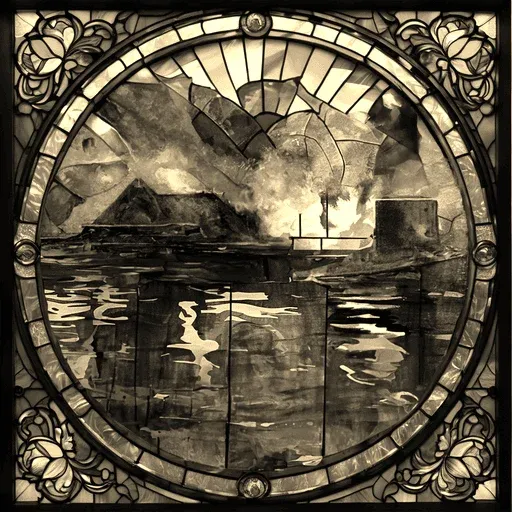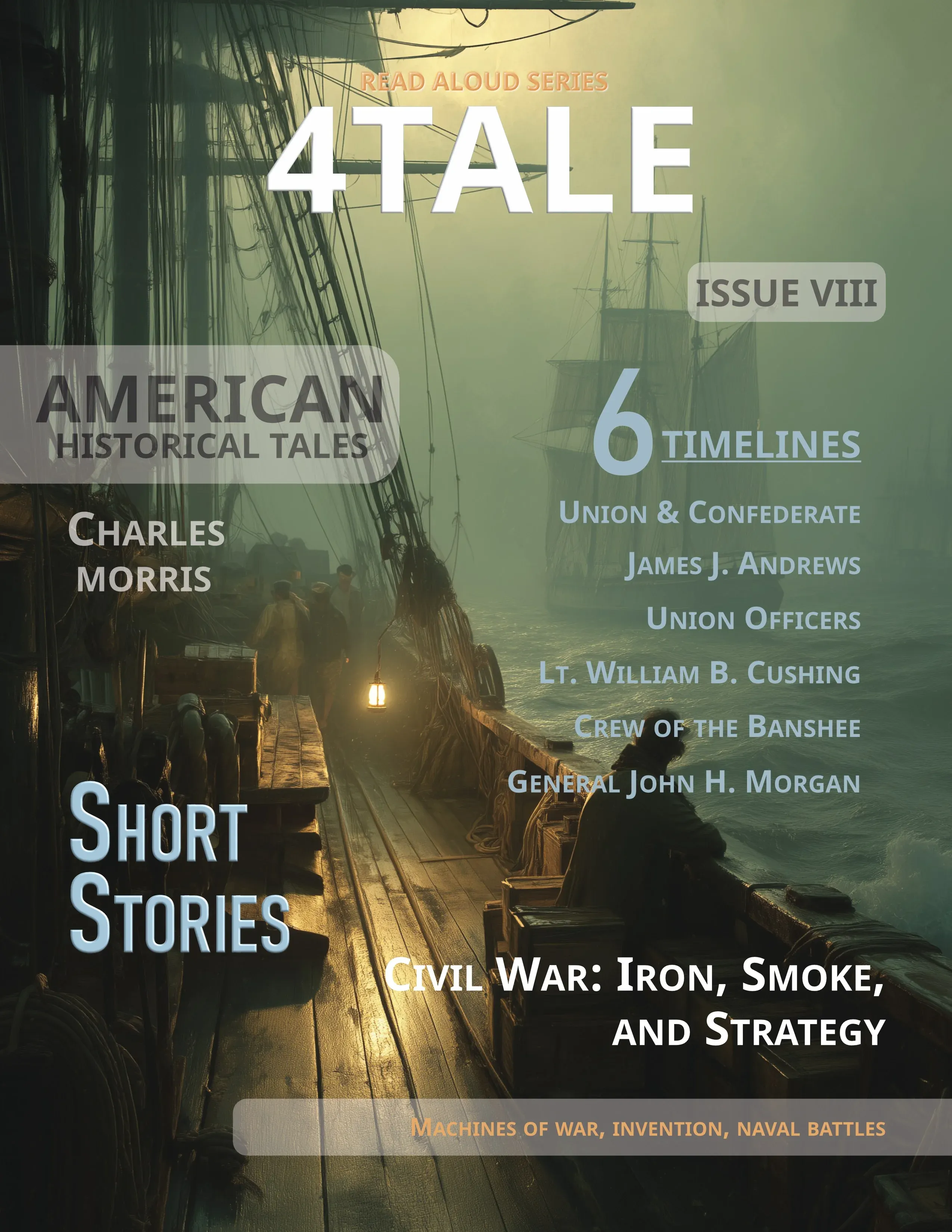On the 9th of March, 1862, for the first time in human history, two iron-clad ships met in battle. The occasion was a memorable one, and its story is well worthy of being retold in our cycle of historic events. For centuries, for thousands of years, in truth, wooden vessels had been struggling for the mastery of the seas. With the first shot fired from the turret of the Monitor at the roof-like sides of the Merrimac, in the early morning of the day named, the long reign of wooden war vessels ended; that of iron monarchs of the deep began. England could no more trust to her "wooden walls" for safety, and all the nations of Europe, when the echo of that shot reached their ears, felt that the ancient era of naval construction was at an end, and that the future navies of the world must ride the waves clad in massive armor of steel.
On the 8th of March, indeed, this had been shown. On that day the Merrimac steamed down from Norfolk harbor into Hampton Roads, where lay a fleet of wooden men-of-war, some of them the largest sailing frigates then in the American navy. On shore soldiers were encamped, here Union, there Confederate; and the inmates of the camps, the garrison of Fortress Monroe, the crews of the ships at anchor under its guns, all gazed with eager eyes over the open waters of the bay, their interest in the coming contest as intense as Roman audience ever displayed for the life and death struggle in the gladiatorial arena. Before them lay a mightier amphitheatre than that of the Coliseum, and before them was to be fought more notable struggle for life and death than ever took place within the walls of mighty Rome.
It was in the afternoon of the 8th, about one o'clock, that the long roll sounded in the camps on shore, and the cry resounded from camp to camp, "The Merrimac is coming!" For several weeks she had been looked for, and preparations made for her reception. The frigates bore a powerful armament of heavy guns, ready to batter her iron-clad sides, and strong hopes were entertained that this modern leviathan would soon cease to trouble the deep. The lesson fixed by fate for that day had not yet been learned.
Down the bay she came, looking at a distance like a flood-borne house, its sides drowned, only its sloping roof visible. The strange-appearing craft moved slowly, accompanied by two small gunboats as tenders. As she came near no signs of life were visible, while her iron sides displayed no evidence of guns. Yet within that threatening monster was a crew of three hundred men, and her armament embraced ten heavy cannon. Hinged lids closed the gun-ports; raised only when the guns were thrust forward for firing. As for the men, they were hidden somewhere under that iron roof; to be felt, but not seen.
What followed has been told in song and story; it need be repeated here but in epitome. The first assault of the Merrimac was upon the Cumberland, a thirty-gun frigate. Again and again the thirty heavy balls of the frigate rattled upon the impenetrable sides of the iron-clad monster, and bounded off uselessly into the deep. The Merrimac came on at full speed, as heedless of this fusillade as though she was being fired at with peas. As she approached, two heavy balls from her guns tore through the timbers of the Cumberland. They were followed by a stunning blow from her iron beak, that opened a gaping wound in the defenceless side of her victim. Then she drew off, leaving her broken beak sticking in the ship's side, and began firing broadsides into the helpless frigate; raking her fore and aft with shell and grape, despite the fact that she had already got her death-blow, and was rapidly filling with water.
Never ship was fought more nobly than the doomed Cumberland. With the decks sinking under their feet, the men fought with unflinching courage. When the bow guns were under water, the rear guns were made to do double duty. The captain was called on to surrender. He sternly refused. The last shot was fired from a gun on a level with the waves. Then, with sails spread and flags flying, the Cumberland went down, carrying with her nearly one hundred of her crew, the remainder swimming ashore. The water was deep, but the topmast of the doomed vessel still rose above the surface, with its pennant waving in the wind. For months afterwards that old flag continued to fly, as if to say, "The Cumberland sinks, but never surrenders."
The Congress, a fifty-gun frigate, was next attacked, and handled so severely that her commander ran her ashore, and soon after hoisted the white flag, destruction appearing inevitable. Boats were sent by the enemy to take possession, but a sharp fire from the shore drove them off.
"Is this in accordance with military law?" asked one of the officers in the camp. "Since the ship has surrendered, has not the enemy the right to take possession of her?"
This legal knot was quickly and decisively cut by General Mansfield, in an unanswerable decision.
"I know the d——d ship has surrendered," he said. "But we haven't." And the firing continued.
The Merrimac, not being able to seize her prize, opened fire with hot shot on the Congress, and quickly set her on fire. Night was now at hand, and the conquering iron-clad drew off. The Congress continued to burn, her loaded guns roaring her requiem one after another, as the fire spread along her decks. About one o'clock her magazine was reached, and she blew up with a tremendous explosion, the shock being so great as to prostrate many of those on the shore.
So ended that momentous day. It had shown one thing conclusively, that "wooden walls" could no longer "rule the wave." Iron had proved its superiority in naval construction. The next day was to behold another novel sight,—the struggle of iron with iron.
Morning came. The atmosphere was hazy. Only as the mist slowly lifted were the gladiators of that liquid arena successively made visible. Here, just above the water, defiantly floated the flag of the sunken Cumberland. There smoked the still-burning hull of the Congress. Here, up the bay, steamed the Merrimac, with two attendants, the Yorktown and the Patrick Henry. Yonder lay the great hull of the steam-frigate Minnesota, which had taken some part in the battle of the day before, but had unfortunately gone ashore on a mud-bank, from which the utmost efforts failed to force her off. Other Union naval vessels were visible in the distance.
The Merrimac made her way towards the Minnesota, as towards a certain prey. Her commander felt confident that an hour or two would enable him to reduce this great vessel to the condition of her recent companions.
Yet an odd sight met his vision. Alongside the Minnesota floated the strangest-looking craft that human eye had ever gazed upon. An insignificant affair it appeared; a "cheese-box on a raft" it was irreverently designated. The deck, a level expanse of iron, came scarcely above the surface. Above it rose a circular turret, capable of being revolved, and with port-holes for two great guns, among the largest up to that time used in naval warfare.
How this odd contrivance came there so opportunely may be briefly told. It was the conception of John Ericsson, the eminent Swedish engineer, and was being rapidly built in New York while the Merrimac was being plated with thick iron bars in Norfolk. A contest for time took place between these two unlike craft. Spies were in both places, to report progress. Fortunately, the Monitor was finished a day or two before her competitor. Immediately she steamed away for Hampton Roads. The passage was a severe one. Three days were consumed, during which the seas swept repeatedly over the low deck, the men being often half suffocated in their confined quarters, the turret alone standing above the water. As they approached Fortress Monroe the sound of cannonading was heard. Tarrying but a few minutes at the fort, the Monitor, as this odd vessel had been named, approached the Minnesota, and reached her side at a late hour of the night.
And now, with the new day, back to the fray came the Merrimac, looking like a giant in comparison with this dwarfish antagonist. As she approached, the little craft glided swiftly in front of her grounded consort, like a new David offering battle to a modern Goliath. As if in disdain of this puny antagonist, the Merrimac began an attack on the Minnesota. But when the two eleven-inch guns of the Monitor opened fire, hurling solid balls of one hundred and sixty-eight pounds' weight against the iron sides of her great opponent, it became at once evident that a new move had opened in the game, and that the Merrimac had no longer the best of the play.
The fight that followed was an extraordinary one, and was gazed on with intense interest by the throng of spectators who crowded the shores of the bay. The Merrimac had no solid shot, as she had expected only wooden antagonists. Her shells were hurled upon the Monitor, but most of them missed their mark, and those that struck failed to do any injury. So small was the object fired at that the great shells, as a rule, whirled uselessly by, and plunged hissing into the waves. The massive solid balls of the Monitor were far more effective. Nearly every one struck the broad sides of the Merrimac, breaking her armor in several places, and shattering the wood backing behind it. Many times the Merrimac tried to ram her small antagonist, and thus to rid herself of this teasing tormentor, but the active "cheese-box" slipped agilely out of her way. The Monitor in turn tried to disable the screw of her opponent, but without success.
Unable to do any harm to her dwarfish foe, the Merrimac now, as if in disdain, turned her attention to the Minnesota, hurling shells through her side. In return the frigate poured into her a whole broadside at close range.
"It was enough," said the captain of the frigate afterwards, "to have blown out of the water any wooden ship in the world." It was wasted on the iron-clad foe.
This change of action did not please the captain of the Monitor. He thrust his vessel quickly between the two combatants, and assailed so sharply that the Merrimac steamed away. The Monitor followed. Suddenly the fugitive vessel turned, and, like an animal moved by an impulse of fury, rushed head on upon her tormentor. Her beak struck the flat iron deck so sharply as to be wrenched by the blow. The great hull seemed for the moment as if it would crowd the low-lying vessel bodily beneath the waves. But no such result followed. The Monitor glided away unharmed. As she went she sent a ball against the Merrimac that seemed to crush in her armored sides.
At ten o'clock the Monitor steamed away, as if in flight. The Merrimac now prepared to pay attention again to the Minnesota, her captain deeming that he had silenced his tormenting foe. He was mistaken. In half an hour the Monitor, having hoisted a new supply of balls into her turret, was back again, and for two hours more the strange battle continued.
Then it came to an end. The Merrimac turned and ran away. She had need to,—those on shore saw that she was sagging down at the stern. The battle was over. The turreted iron-clad had driven her great antagonist from the field, and won the victory. And thus ended one of the strangest and most notable naval combats in history.
During the fight the Monitor had fired forty-one shots, and been struck twenty-two times. Her greatest injury was the shattering of her pilot-house. Her commander, Lieutenant Worden, was knocked senseless and temporarily blinded by the shock. On board the Merrimac two men were killed and nineteen wounded. Her iron prow was gone, her armor broken and damaged, her steam-pipe and smoke-stock riddled, the muzzles of two of her guns shot away, while water made its way into her through more than one crevice.
Back to Norfolk went the injured Merrimac. Here she was put into the dry-dock and hastily repaired. After that had been done, she steamed down to the old fighting-ground on two or three occasions, and challenged her small antagonist. The Monitor did not accept the challenge. If any accident had happened to her the rest of the fleet would have been lost, and it was deemed wisest to hold her back for emergencies.
On the 10th of May the Confederates marched out of Norfolk. On the 11th the Merrimac was blown up, and only her disabled hull remained as a trophy to the victors. As to her condition and fighting powers, one of the engineers who had charge of the repairs upon her said,—
"A shot from the Monitor entered one of her ports, lodged in the backing of the other side, and so shivered her timbers that she never afterwards could be made seaworthy. She could not have been kept afloat for twelve hours, and her officers knew it when they went out and dared the Monitor to fight her. It was a case of pure bluff; we didn't hold a single pair."
The combat we have recorded was perhaps the most important in the history of naval warfare. It marked a turning-point in the construction of the monarchs of the deep, by proving that the future battles of the sea must be fought behind iron walls.







